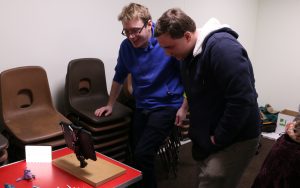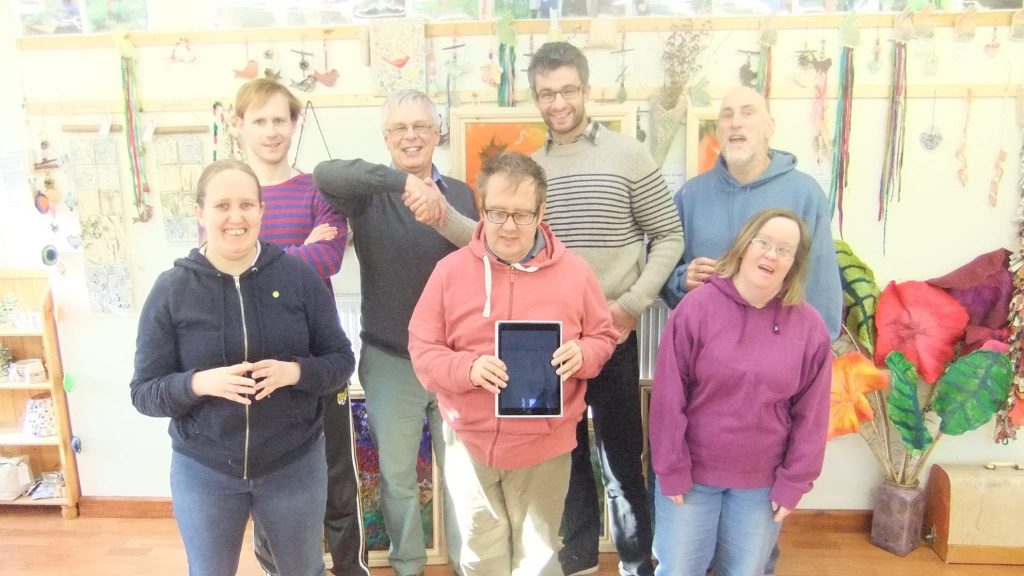Category Archives: Blog
Week 1 – Back in the NAS Lynx!
This was the first workshop of six that we are running at the NAS Lynx Centre in Weston Super Mare as part of the Exploring Diagnosis project.
Last time we were here we had workshops for larger groups of people, perhaps 20 at once, and we set up simultaneous activities like a green screen, iPads and modelling clay for animation.
This time, Dom (workshop leader) and Lena (the centre manager) discussed smaller groups for people who expressed an interest in animation.
Dom writes
People are often reluctant to re-do a thing that isn’t right the first time because “it took ages”, though the “ages” in question are usually between 5 and 10 minutes. I’m hoping to get to the point where the animators are happy to look at what they’ve done and if it isn’t quite how they hoped perhaps make it again, taking into account what they’ve learnt.
Workshops at the NAS Lynx Centre in Weston Super Mare
- where do you work?
- what’s your working pattern like?
- skills?
- techniques?
- what support do you think you might need?
EU-AIMS scientists answer questions from the autism community about EU-AIMS research
Sixty-six individuals submitted written comments on the consortium’s research after these events, most were questions that autistic adults or parents of individuals with autism had raised. We summarised their questions in this video and put them to the scientists at the EU-AIMS 6th annual Meeting in 2017.
An associated paper is available here http://blogs.exeter.ac.uk/exploringdiagnosis/files/2017/11/hex.pdf
Film Workshops Review
Last year we ran a series of workshops for autistic adults at venues across the South West and South Wales. The idea was to experiment with different visual techniques like stop motion and cut-out animation, green-screen technology and motion sensor software to allow the participants to come up with their own creative work. Here’s a short selection of clips:
Participants loved it – animation opened up new ways of expression and staff were amazed to see certain individuals engaging with such enthusiasm. We left animation kit at each venue and this is in high demand everywhere!
ReacTickles Web Apps
Following the excitement about ReacTickles at the St. Mark’s House workshop, [http://blogs.exeter.ac.uk/exploringdiagnosis/st-marks-house-workshop/] Exploring Diagnosis have been working with the Cariad Interactive design team, Wendy Keay-Bright and Joel Gethin Lewis, [http://cariadinteractive.com/about/] to re-create some of the most popular ReacTickles for the web. This means that there is no need to purchase or download any software, you can just click on the images and start playing, using your mouse, keyboard, iPhone or iPad.
Based on the feedback from St Marks’ and some of the demos we posted earlier [http://blogs.exeter.ac.uk/exploringdiagnosis/reacticklesdemo/] Joel has been busy programming many new ReacTickles, and we have chosen three examples for Exploring Diagnosis. These are,
Bouncing Circles – use your keyboard to explore speed, position and pressure
Keyboard Worm – use your keyboard to explore velocity
Springy Circles – use your mouse to explore elasticity
Each of the ReacTickles, will trace your interaction, creating real-time animations while you explore. Using the Quicktime > New Screen Recording Option, [https://www.youtube.com/watch?v=84nuErTMv2w] you can easily record and save your animation.
Wendy and Joel are working on more ReacTickles for web. We will be posting more about these in the future, and you can follow their progress on the Cariad Interactive website [http://cariadinteractive.com/2017/01/17/original-reactickles-revisited/].
iPad gift to Stallcombe House
This picture was taken on a recent visit to Stallcombe House, where EXDX team member Dr. Chris Elphick gave the residents their very own iPad to use. He is pictured shaking hands with Chris Thistle, the general manager of Stallcombe. Having this iPad will enable the residents to continue to make the stop-motion videos, as seen on the ‘Film Workshops’ section of this website. In addition to this, residents will be able to explore the use of the Somantics and ReacTickles apps we have also started to use in our more recent workshops. Dr. Elphick is looking forward to attending the Stallcombe Christmas party on Sunday the 11th of December.
The Team from St Mark’s House workshop
St Mark’s House workshop
St Mark’s House in Newport, Gwent was the next destination for our workshops, this time with the National Autistic Society group who meet there regularly. We had the regular plasticine table that proved as popular as ever with carers and clients alike. It’s really nice and social just to roll dough and chat. Before long, hey presto, you have something you can animate on the Ipad using the I Stop Motion software.
Notice we’ve clamped the Ipads to the tables using a piece of wood and g–clamps, this saves damaging the table and keeps them still and free of jolting and jogging.
We also had roving two Ipads that clients could take anywhere in the building and interact using the ReacTickles Magic and Somantics Software from Cardiff School of Art and Design and Cariad Interative. This amazing program allows the user to touch, gesture and use sound to create movement and reaction on the screen. We monitored the use from two laptops and recorded some of the sessions.
For a bigger more dynamic experience we used another Cardiff School of Art and Design and Cariad Interactive program, Somantics, and a projector, screen and Xbox 360 Kinect camera to capture physical movement. The set up was a real attraction, causing traffic jams as centre users passed by.
A big thank you to animators and facilitators Dominic Pitt, Sophie Marsh and Lizzie Watts for their excellent support throughout the workshop series.
Animation for people with (and without) autism.
This video is made using a program called ReacTickles, designed to encourage children to explore computers and interactive whiteboards in a relaxing, experimental manner. The most recent version of this programme is called ReacTickles Magic – which can be used as an iPad app or a computer program. Using a variety on inputs – such as pressing the iPad screen, using the computer mouse or keyboard, gesture and audio input – like clapping or making any sound chosen by the user, it is possible to produce the striking images in this demo video. The intention is to allow users to playfully discover the possibilities of an interactive system with no previous knowledge or experience of the technology. We plan on exploring the use of ReacTickles Magic in our next workshop.
Thanks to Wendy Keay-Bright for letting us demonstrate this software.











